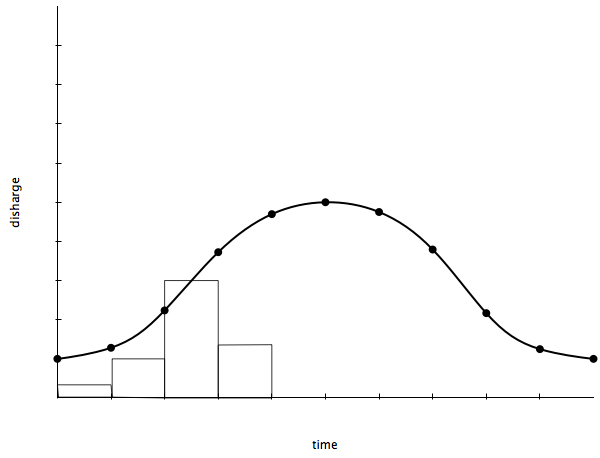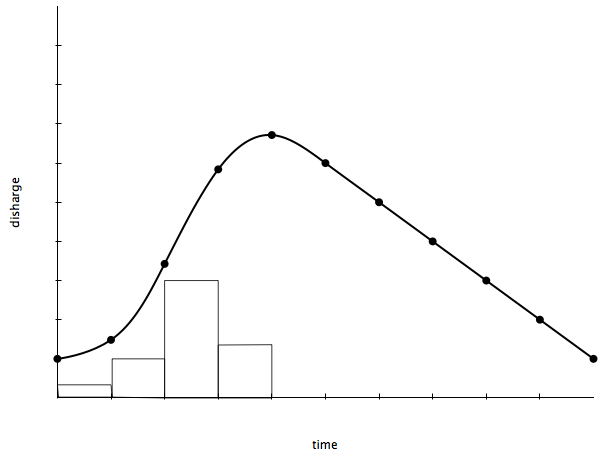Flood Hydrographs
Flood hydrographs help predict flooding patterns.
Hydrographs illustrate river discharge and rainfall over time. Over the short term, a flood or storm hydrograph (figure 1.) can show short-term variations in discharge and rainfall. They cover a relatively short time period, usually hours or days rather than weeks or months. Storm hydrographs allow us to investigate the relationship between a rainfall event and discharge.
A flood hydrograph shows the amount of rainfall and river discharge in an area. The discharge of a river is the volume of water passing a point each second. It is expressed in cumecs (cubic metres per second). River discharge is displayed as a line graph. Precipitation is shown as a bar graph and is usually indicated in millimetres.
The starting and finishing levels show the base flow of a river. The base flow is the water that reaches the channel through slow throughflow and permeable rock below the water table. As stormwater enters the drainage basin, the discharge rates increase. This is shown in the rising limb. The highest flow in the channel is known as the peak discharge. The fall in discharge back to base level is shown in the preceding limb. The lag time is the delay between maximum rainfall and peak discharge.
The shape of a hydrograph varies in each river basin and each storm event.
Flood hydrographs can predict flooding by showing how different precipitation levels affect a river during a storm.
Hydrographs can be of different shapes. The characteristics of a river, its drainage basin and the amount of water entering the system affect the shape of a flood hydrograph.
A gentle hydrograph shows the river is at low risk of flooding. These types of hydrographs have a gentle rising limb and a long lag time, which means it takes longer for the peak rainfall to reach the river channel, so the river discharge is increasing slowly.

A gentle hydrograph
Flashy hydrographs have a steep rising limb and a small lag time. This indicates that river discharge increases rapidly over a short period, indicating rainwater reaches the river very quickly. This means the river is more likely to flood.

A flashy hydrograph
Rural areas with predominantly permeable rock increase infiltration and decrease surface runoff. This increases lag time. The peak discharge is also lower as it takes water longer to reach the river channel.
A range of physical factors affect the shape of a storm hydrograph. These include:
A range of human factors affect the shape of a storm hydrograph. These include:
Key Terms
Hydrograph – a graph that shows river discharge and rainfall over time.
Flood – when the capacity of a river to transport water is exceeded, and water flows over its banks.
Base flow – The base flow of the river represents the normal day-to-day discharge of the river and is the consequence of groundwater seeping into the river channel.
Storm flow – storm runoff resulting from storm precipitation involving surface and through flow.
Bankful discharge – the maximum discharge that a particular river channel can carry without flooding.
Peak discharge – the point on a flood hydrograph when river discharge is at its greatest.
Peak rainfall – the point on a flood hydrograph when rainfall is at its greatest.
Lag time – the period between the peak rainfall and peak discharge.
Use the images below to explore related GeoTopics.